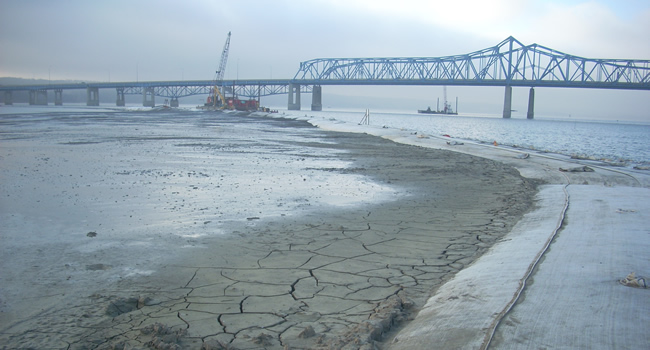It’s long been said that investing in land is smart because “they aren’t making more of it.” In general, this is true. Mitigation strategies create more habitat, but not more land—except in the case of an artificial island.
The project noted below was originally published on Geosynthetica in 2013, but its relevance remains. More of these islands are in planning, in fact, including multiple of them in Illinois. May is also American Wetlands Month, making this a perfect time to look back at this unique project that may well come again and quite soon.
PEORIA’S ARTIFICIAL ISLAND
The US Army Corps of Engineers (Rock Island District) created the 21-acre artificial island in 2013 in Lower Peoria Lake. The island was made with dredged sediment, a process that helped restore a deep water fisheries habitat in the lake and improve navigation of channel, which is part of the Illinois Waterway.
The design involved a ring of geotextile tubes, which were used to establish the island’s 4,800-ft perimeter. This structure created a bermed disposal area for backfilling with dredged soils. Not only did the work create deeper waters for fish and navigation, it established a new vegetative wetland habitat.
Maccaferri’s geotextile containers were used to provide structural integrity to the designed island system. Three rows of tubes were set at the base with a fourth tube row added on top. Each tube was filled to a height of six feet with dredged river soils. The soils, excavated from 5,700 linear feet of channel, were screened and mixed with water to create a strong slurry that when pumped into the containers stabilized the island’s edge.
Midwest Foundation Corporation served as the general contractor.

Artificial island creation was a fairly popular topic 10 – 15 years ago, largely due to numerous artificial island and archipelago plans in the United Arab Emirates. The rather amazing Palm Jumeirah was completed, though sister projects were put on hold or scaled back significantly following the 2008 financial crisis. The 300-island plan for a development called The World hasn’t yielded much investment, but after years of hiatus there are signs of significant developing restarting for these artificial island installations.
MORE GEO: Abigail Gilson and Carl Charpentier are our first GeoCreatives profiles
In Dubai, the purpose of the islands is tourism and real estate. (They even have high-end housing known as “floating seahorses.”) In Peoria, it’s for habitat, fisheries, and shipping navigation.
Regardless of the reason for developing an artificial island, the engineering is fascinating.

In Peoria, once the stable ring of geotextile tubes had been established, additional spoils were filled in behind it. Vegetation took hold quickly and an upland habitat was created for nesting birds, snakes, and other wildlife.
This island may not come with a flashy development name or mega resort, but it is a beautiful installation. It is also creating and restoring something we must not neglect: wildlife habitat.











